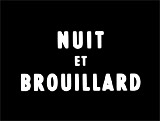
|
Night and Fog (1955, Fr.)
(aka Nuit et Brouillard)
In director Alain Resnais' documentary-style short
film about the horrors of war - a potent and very poignant
French documentary about genocide filmed 10 years following the
end of WWII, providing a profound exploration of the sinister
Nazi concentration death camps at Auschwitz-Birkenau and Majdanek;
the haunting movie about the barbarity
of the "Final Solution" was descriptively narrated (a detached
voice-over by Michel Bouquet).
The title of the film referred to the "Night and
Fog" Decree (Nacht und Nebel Erlass) issued on December
7, 1941 by Adolf Hitler that called for the seizure of "persons
endangering Germany's security."
- the documentary began by surveying the
colorful, present "peaceful
landscape" around the former main death camp, with
barbed wire fencing, the railroad tracks that brought prisoners,
the guard towers, and the abandoned empty buildings where the Jews
were housed and mostly exterminated; these views were interspersed
with archival, historical black and white footage of Hitler addressing
hordes of his followers of the Third Reich at Nuremberg in 1933
during his rise to power ("The machine gets underway")

Opening Tracking Shot
|

Archival Footage - Hitler
|

Abandoned Buildings and Barbed Wire Fencing
|
- the camps were built in preparation
for rounding up and moving millions of Jews on crowded and sealed
boxcar trains on tracks leading to the barren camp's living areas:
("Hunger, thirst, suffocation, madness"), arriving in
the "night
and fog" - "The first sight of the camp. It's another
planet"; the sign above the camp's front steel gate read:
"Arbeit Macht Frei" (Labor Liberates) - a deceptive euphemism to
falsely advertise that the locale was a work camp to serve the
Third Reich
- the "political prisoners" were stripped,
shaved, tattooed, numbered, and uniformed, and then housed in crowded
bunk areas (with three to a bunk); during the day, those who were
chosen as workers were marched off to a factory or quarry in all
weather conditions while supervised by the SS (SchutzStaffel, or
the elite guard)
- there were harsh and relentless images of the severity
of treatment, including "hospitals" for lethal drug injections,
"needless operations, amputations, experimental
mutilations," castrations, and chemical factories testing their
toxic products on prisoners ("guinea pigs"), with a view of crude
operating tables with canals that channeled blood to a central
drain; the Kapos (cruel supervisors) at the camps maintained a brothel with
"better-fed women but equally doomed to die"; there were prisons
with inhumane tiny cells designed for torture - air vents were
not soundproof, allowing for the horrors to be heard ("Air vents
don't muffle the cries")
- the film documented how Nazi officer Heinrich Himmler
arrived with the goal of annihilating and exterminating as many
camp prisoners as possible with greater efficiency by building
gas chambers and crematoriums: ("A crematorium might look
a bit like a postcard. Today, tourists have their picture taken
in front of them"); Zyklon B poison gas was used (hydrocyanic
or prussic acid); women and children and the weak and elderly were
often immediately separated upon arrival and executed

A Typical Gas Chamber
|
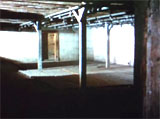
A Fake Shower Room
|

Piled Up Bodies
|
- the film photographed the outside and interior of
a typical gas chamber, constructed to appear to be a shower room
(with locked doors), with close-ups of finger-nail scratch marks
on the concrete ceiling of a gas chamber; newly-constructed crematoriums
were very successful: ("The new ovens
consumed thousands of bodies a day"), but couldn't
handle the backlog of bodies, so large wooden pyres were built: "When
the crematoria prove insufficient, pyres are set up"

Discarded Eyeglasses
|
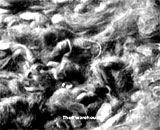
Shaved Off Women's Hair
|

Human Bones For Fertilizer
|
- the film built to a climax with shocking, gruesome,
sobering and horrific images of the Holocaust victims - with stockpiles
of discarded eyeglasses, hair combs, clothing, warehouse piles
of shaved-off women's hair (to make cloth material and rugs) and
bones (to make fertilizer), and rooms filled with
emaciated dead bodies (to make soap) [Note: There was actually no evidence
that the Nazis made soap from corpses. This one factual error in
the film was used by certain groups to argue that
the entire Holocaust was a myth.]
-
decapitated heads were stacked neatly in large buckets; human skin
was used to make sheets of paper
|
Bulldozing the Corpses Into Mass Grave-Pits
|
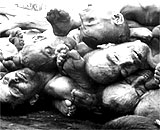
|

|

|
- the lifeless corpses were bulldozed into a mass
grave
- the film concluded with the liberation of the country
and the camps, and questioning who was responsible for the atrocities;
kapos and officers all testified: "I'm not responsible"
- the narrator then memorably
asked as the film returned to views of the present day facility
and surveyed the ruins: "Then
who is responsible. As I speak to you now, cold water from the
ponds and ruins fills the mass graves, a water as cold and murky
as our own faulty memory. War has dozed off - one eye still open....
Nine million dead haunt this landscape"
[Note: The actual figure of the deceased was 11 million, six million
Jews and five million non-Jews.]
- the film pondered
questions about why and how the apocalyptic Holocaust had ever happened,
and how it might inform the historical future with a final warning
that the unique event could be repeated - and the urgent need for
vigilance if we ever forget the past (in the fog of suppression): "Who
among us keeps watch from this strange watchtower to warn of the
arrival of new executioners? Are their faces really so different
from ours?"
- the narration ended: "We survey these ruins
with a heartfelt gaze, certain the old monster lies crushed beneath
the rubble. We pretend to regain hope as the image recedes, as
though we've been cured of that plague. We tell ourselves it was
all confined to one country, one point in time. We turn a blind
eye to what surrounds us and a deaf ear to the never-ending cries"
|

Loading Boxcars

Rail Tracks Leading to The Concentration Camp

Arrival at the Camp in the "Night and Fog" - With

Stripped Prisoners

Uniformed, Shaved Workers

Skeletal Figure in a "Hospital"

Burned Bodies in Pyres
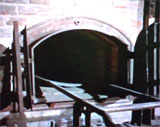
A Typical Crematorium


Piles of Bodies - Decapitated Heads

Depositing a Corpse Into a Grave

Faces of Victims Being Liberated Behind Barbed Wire
|













